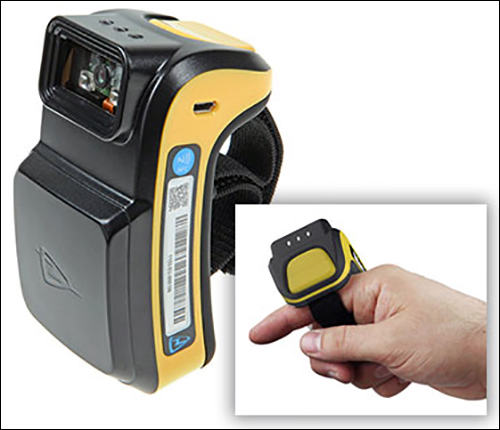RFID use at construction sites helps workers and management to collect and view information regarding the equipment, assets or inventory that moves around their work sites. But when handheld devices are used to collect that data, workers can lose one important tool: a free hand.
Atlas RFID Solutions offers a wearable ultrahigh-frequency (UHF) RFID reader that helps workers keep their hands free when they interrogate tags on the goods they handle, or that are within their vicinity. The reader, from Technology Solutions (UK) Ltd. (TSL), is worn on the back of a user’s hand, in the form of a ring over two fingers, enabling individuals to have full use of both hands while also reading tags.
Atlas RFID is marketing the product for its industrial construction customers, says Jeff Burns, Atlas RFID Solutions’ associate hardware product manager. Ruggedized handheld readers are needed in such scenarios, Burns says, but are cumbersome for workers. Altas is a software and solutions company that, since 2011, has been selling its Jovix material-readiness application for builders of factories, oil and gas rigs, and oil drill sites. Traditionally, its services include a software platform and mobile apps to manage data from active RFID to manage high-value assets at work sites, in warehouses or in laydown yards.
Jovix technology provides users with location information, as well as reports indicating where their assets are located. This includes at which site and the location within that site, which can be linked to that item’s maintenance and other records. But during the past year or so, the company has been providing customers with more hybrid solutions that incorporate both passive and active RFID, depending on the particular asset being tracked. For instance, passive RFID tags can be attached to lower-value items that do not require real-time location, but rather could be identified within zones.
Atlas RFID uses third-party manufacturers for its active or passive RFID technology, including a variety of passive RFID tags, depending on the form factor and material of goods being tagged. Some of its customers have installed fixed RFID portal readers for passive tag tracking, as well as installing RFID readers on forklifts and other vehicles. But in some cases, gates and vehicles do not offer sufficient visibility, especially if RFID-tagged items are stored in a corner, behind other items, so that they are difficult to reach.
Atlas provides handheld RFID readers that can be lower in cost and more mobile than a fixed RFID gate or forklift reader, but these can provide ergonomic problems for users. Often, the company explains, users may unload a crate or box, stop, pick up a handheld reader, pull the trigger to read tag IDs, and then put it down again. “We have a holster option,” Burns says, but that, too, can be clunky since the handheld isn’t small, yet still requires individuals to have a hand free to remove it from the holster.
Burns says the company has been watching technology evolve, with some bar-code scanners being built into rings or glasses. “We started looking into that,” he states, and the ring reader resulted.
The TSL RFID reader ring is designed to be strapped around the index and middle fingers. Once activated, it can interrogate UHF RFID tags within a range of 2 meters (6.6 feet), as well as scan 1D and 2D bar codes. The device comes with only a single large button. Users can simply press the button once to awaken it and pair to a Bluetooth device, and then a second time to begin reading RFID tags. They can tap the button twice to scan a bar code.
The device, once it has been activated and paired to a smartphone or other Bluetooth device and instructed to read tags, will automatically capture the ID numbers of any RFID tags within its read range. It will emit an audible beep each time it reads a tag. That data is then forwarded via Bluetooth to the user’s phone or tablet, which employs the Jovix app to manage the information and forward it to the cloud-based server.
The ring reader shines an LED light when in operation, and the light turns off if it goes to sleep. It can indicate, based on the light, when battery power is low. Although it can operate for many hours or days during testing, Burns says, the company recommends that users recharge the readers at the end of each day.
The reader can be used most commonly in one of three scenarios, Burns says. Receivers who scan items as they come off a truck can read the tags by waving their hand near the items, or simply read them as they pick up and move tagged goods. The tag IDs are collected and transmitted to the mobile device running the Jovix app, and that data is linked to the GPS data on the phone and forwarded to the cloud-based server.
Pickers who collect items to fulfill orders could strap the ring reader to one hand while moving around a storage area. They could use the Jovix app to pull up GPS-based data about the locations of the items they seek, then activate the reader in Geiger-counter mode in order to find those goods upon reaching the appropriate location. The app also enables users to store a picture of an item along with its identification in the app, so that they can view the picture at the work site as they seek it for picking.
Finally, Burns says, the technology works well for sweeping functions. In this case, workers can simply move throughout an area with the ring reader, and the tag IDs within their vicinity will be captured, paired with GPS data and sent to the server to update each item’s location and status. “Anyone can then open a map [in the software] and see the updated location,” he states.
The Jovix app currently works on Android devices, as well as on Atlas RFID’s Windows 10 ruggedized tablets; the technology is expected to be made available for iOS devices next year. What’s more, the ring reader is glove-compatible, so it can fit over work gloves and still remain operable.



